Thurgood Marshall was the first African American to serve on the Supreme Court of the United States.
People and institutions etc. named after Thurgood Marshall are:

Thoroughgood "Thurgood" Marshall was an American civil rights lawyer and jurist who served as an associate justice of the Supreme Court of the United States from 1967 until 1991. He was the Supreme Court's first African-American justice. Prior to his judicial service, he was an attorney who fought for civil rights, leading the NAACP Legal Defense and Educational Fund. Marshall was a prominent figure in the movement to end racial segregation in American public schools. He won 29 of the 32 civil rights cases he argued before the Supreme Court, culminating in the Court's landmark 1954 decision in Brown v. Board of Education, which rejected the separate but equal doctrine and held segregation in public education to be unconstitutional. President Lyndon B. Johnson appointed Marshall to the Supreme Court in 1967. A staunch liberal, he frequently dissented as the Court became increasingly conservative.

Marshall is a city in the U.S. state of Texas. It is the county seat of Harrison County and a cultural and educational center of the Ark-La-Tex region. At the 2020 U.S. census, the population of Marshall was 23,392; The population of the Greater Marshall area, comprising all of Harrison County, was 65,631 in 2010, and 66,726 in 2018.
Separate but equal was a legal doctrine in United States constitutional law, according to which racial segregation did not necessarily violate the Fourteenth Amendment to the United States Constitution, which nominally guaranteed "equal protection" under the law to all people. Under the doctrine, as long as the facilities provided to each "race" were equal, state and local governments could require that services, facilities, public accommodations, housing, medical care, education, employment, and transportation be segregated by "race", which was already the case throughout the states of the former Confederacy. The phrase was derived from a Louisiana law of 1890, although the law actually used the phrase "equal but separate".
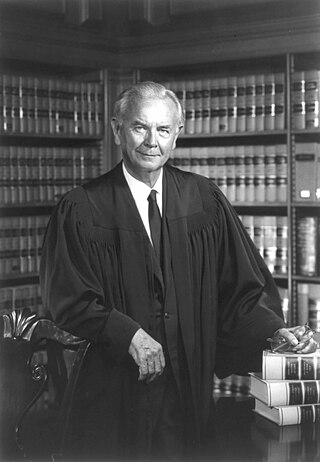
William Joseph Brennan Jr. was an American lawyer and jurist who served as an Associate Justice of the Supreme Court of the United States from 1956 to 1990. He was the seventh-longest serving justice in Supreme Court history, and was known for being a leader of the Court's liberal wing.
Sweatt v. Painter, 339 U.S. 629 (1950), was a U.S. Supreme Court case that successfully challenged the "separate but equal" doctrine of racial segregation established by the 1896 case Plessy v. Ferguson. The case was influential in the landmark case of Brown v. Board of Education four years later.

The United States Court of Appeals for the Second Circuit is one of the thirteen United States Courts of Appeals. Appeals from the second circuit are heard by the Supreme Court of the United States. Its territory comprises the states of Connecticut, New York and Vermont. The court has appellate jurisdiction over the district courts in the following districts:
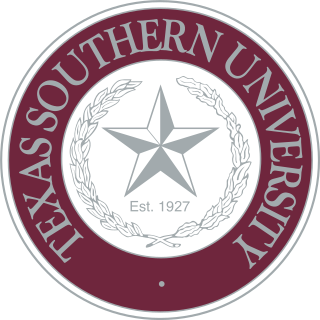
Texas Southern University is a public historically black university in Houston, Texas. The university is one of the largest and most comprehensive historically black college or universities in the United States with nearly 8,000 students enrolled and over 100 academic programs. The university is a member school of the Thurgood Marshall College Fund and it is accredited by the Southern Association of Colleges and Schools. It is classified among "R2: Doctoral Universities – High research activity".

The NAACP Legal Defense and Educational Fund, Inc. is a leading United States civil rights organization and law firm based in New York City.
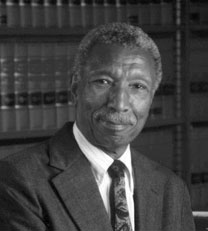
Robert Lee Carter was an American lawyer, civil rights activist and a United States district judge of the United States District Court for the Southern District of New York.

Foley Square, also called Federal Plaza, is a street intersection in the Civic Center neighborhood of Lower Manhattan, New York City, which contains a small triangular park named Thomas Paine Park. The space is bordered by Worth Street to the north, Centre Street to the east, and Lafayette Street to the west, and is located south of Manhattan's Chinatown and east of Tribeca. It was named after a prominent Tammany Hall district leader and local saloon owner, Thomas F. "Big Tom" Foley (1852–1925).

Aloysius Leon Higginbotham Jr. was an American civil rights advocate, historian, presidential adviser, and federal court judge. From 1990 to 1991, he served as chief judge of the United States Court of Appeals for the Third Circuit. Originally nominated to the bench by President Kennedy in 1963, Higginbotham was the seventh African-American Article III judge appointed in the United States, and the first African-American United States district judge of the United States District Court for the Eastern District of Pennsylvania. He was elevated to the Third Circuit in 1977, serving as a federal judge for nearly 30 years in all. In 1995, President Bill Clinton awarded him the Presidential Medal of Freedom. Higginbotham used the name "Leon" informally.

Robert Allen Katzmann was a United States circuit judge of the United States Court of Appeals for the Second Circuit. He served as chief judge from September 1, 2013, to August 31, 2020.
The Thurgood Marshall College Fund (TMCF) is an American non-profit organization that supports and represents nearly 300,000 students attending its 47 member-schools that include public historically black colleges and universities (HBCUs), medical schools, and law schools. The organization is named after the Supreme Court's first African-American Justice, Thurgood Marshall.
The Thurgood Marshall School of Law (TMSL) is an ABA-accredited law school at Texas Southern University in Houston, Texas. It awards Juris Doctor and Master of Law degrees. Thurgood Marshall School of Law is a member-school of the Thurgood Marshall College Fund and Association of American Law Schools.
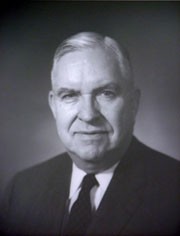
Erwin Nathaniel Griswold was an American appellate attorney and legal scholar who argued many cases before the U.S. Supreme Court. Griswold served as Solicitor General of the United States (1967–1973) under Presidents Lyndon B. Johnson and Richard M. Nixon. He also served as the dean of Harvard Law School for 21 years. Several times he was considered for appointment to the U.S. Supreme Court. During a career that spanned more than six decades, he served as member of the U.S. Commission on Civil Rights and as president of the American Bar Foundation.
Kenneth Michael Hoyt is a senior United States district judge of the United States District Court for the Southern District of Texas.
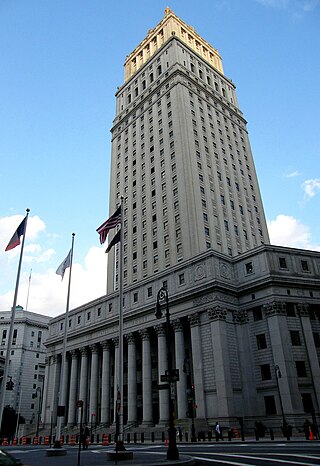
The Thurgood Marshall United States Courthouse is a 37-story courthouse at 40 Centre Street on Foley Square in the Civic Center neighborhood of Lower Manhattan in New York City, United States. Opened in 1936, the building was designed by Cass Gilbert and his son, Cass Gilbert Jr., in the Classical Revival style. The United States Court of Appeals for the Second Circuit and the United States District Court for the Southern District of New York hear cases in the courthouse, which is across the street from the Metropolitan Correctional Center, New York City. It is listed on the National Register of Historic Places and is a New York City designated landmark.

The Daniel Patrick Moynihan United States Courthouse is a courthouse at 500 Pearl Street, along Foley Square, in the Civic Center neighborhood of Lower Manhattan in New York City. The 27-story courthouse, completed in 1996, houses the United States District Court for the Southern District of New York.

The Heman Marion Sweatt Travis County Courthouse is the county courthouse for Travis County, Texas. Located in downtown Austin, Texas, the courthouse holds civil and criminal trial courts and other functions of county government. The courthouse was built between 1930 and 1931 in the then-contemporary PWA Moderne style, and it was later expanded in 1958 and 1962.
Romeo Marcus Williams was an American civil rights attorney who organized large-scale student protests against segregation in Marshall, Texas. He was also a junior partner of Dallas, Texas civil rights attorney, William J. Durham, who served as lead counsel on two landmark U.S. Supreme Court cases, Sweatt v. Painter, and Smith v. Allwright.